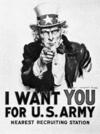- Uncle Sam
-
a personification of the government or people of the U.S.: represented as a tall, lean man with white chin whiskers, wearing a blue tailcoat, red-and-white-striped trousers, and a top hat with a band of stars.[1805-15, Amer.; extension of the initials U.S.]
* * *
Popular U.S. symbol, usually associated with a cartoon figure having long white hair and chin whiskers and dressed in a swallow-tailed coat, vest, tall hat, and striped trousers.The name probably originated with "Uncle Sam" Wilson, a businessman who provided beef to the army during the War of 1812. The "U.S." stamp on his barrels, meant to indicate government property, came to be associated with his nickname, which in time came to symbolize the U.S. government. The Uncle Sam figure evolved in the hands of British and U.S. cartoonists; its most familiar treatment appeared on recruiting posters during World Wars I and II with the caption "I want you." James Montgomery Flagg's representation of Uncle Sam, which was first used on World War I ...By courtesy of the Library of Congress, Washington, D.C.
James Montgomery Flagg's representation of Uncle Sam, which was first used on World War I ...By courtesy of the Library of Congress, Washington, D.C.* * *
▪ United States symbolpopular U.S. symbol usually associated with a cartoon figure having long white hair and chin whiskers and dressed in a swallow-tailed coat, vest, tall hat, and striped trousers. His appearance is derived from two earlier symbolic figures in American folklore—Brother Jonathan and Yankee Doodle.The origin of the term Uncle Sam, though disputed, is usually associated with a businessman from Troy, N.Y., Samuel Wilson, known affectionately as “Uncle Sam” Wilson. The barrels of beef that he supplied the army during the War of 1812 were stamped “U.S.” to indicate government property. This identification is said to have led to the widespread use of the nickname Uncle Sam for the United States; and a resolution passed by Congress in 1961 recognized Wilson as the namesake of the national symbol.Uncle Sam and his predecessor Brother Jonathan were used interchangeably to represent the United States by U.S. cartoonists from the early 1830s to 1861. Cartoonists of the British humour magazine Punch helped evolve the modern figure by their drawings of both Brother Jonathan and Uncle Sam as lean, whiskered gentlemen wearing top hats and striped pants. Probably the first U.S. political cartoonist to crystallize the figure of Uncle Sam was Thomas Nast, beginning in the early 1870s. One of the most familiar treatments in the 20th century was shown in James Montgomery Flagg's World War I recruiting poster, also used in World War II, for which the caption read, “I Want You.”* * *
Universalium. 2010.
